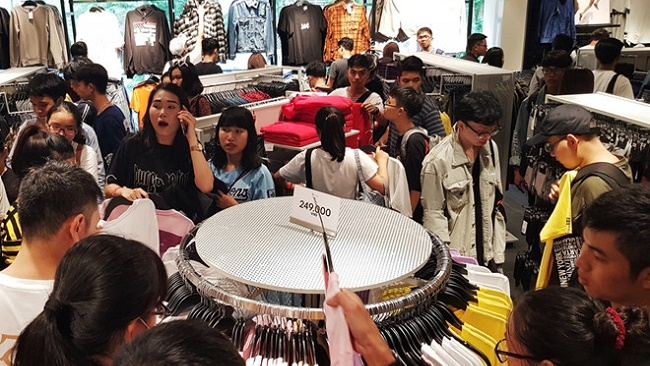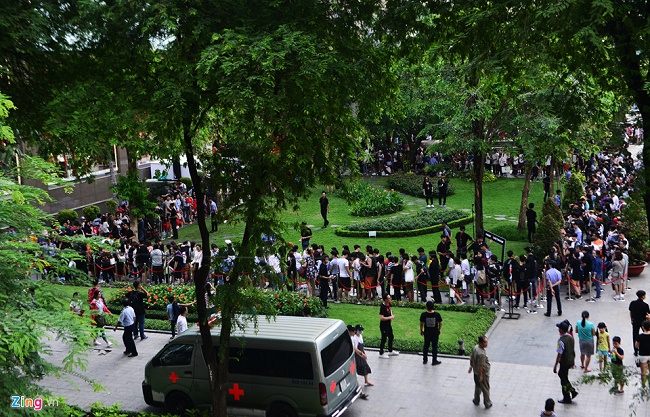LG Innotek secures $200 million IFC loan following revenue drop
LG Innotek Vietnam Hai Phong secured a $200 million IFC loan as revenue slows, aiming to expand camera module production while meeting sustainability targets.




In order to survive, Vietnamese fashion brands must carefully formulate strategies and business operation modes, creating confidence and attraction amongst consumers in the context that international rivals like Zara and H&M are blooming in Vietnam.

Last weekend, a lot of people stayed over night at H&M’s in Ho Chi Minh city from September 8 to buy H&M’s products despite this brand’s announcement to open its new store at exactly 11 o'clock on September 9 when it received over 10,000 people.
After Zara, H&M became a phenomenon in the fashion business in Ho Chi Minh City. How could they do that?
Making customers feel overwhelmed
Displaying goods in three big stores sized up to 2,200 square meters in total at prime locations in Vincom Center, H&M has exploited customers’ curiosity. Zara stores which are opposite to H&M’s also has the same area with the eye-catching display of thousands of products.
While Levi’s, a famous jeans brand, only has a few dozens of samples displayed in Vincom Center, H&M has up to hundreds, with different designs to fully exploit customers’ visual and tactile. Despite providing low-cost garments, H&M always choose to set up stores in luxury commercial buildings to attract young customers not only in Ho Chi Minh City but also in any other cities in the world. In the upcoming time, H&M and Zara will open stores in Hanoi in the same way.
Focusing on fast fashion
Young people’s demand is fast fashion but clothing having long-lasting quality. Therefore, Zara and H&M has continuously released new fashion designs. With a big and widespread design and production network, Zara and H&M released to the market over 10,000 designs annually. H&M has cooperated with 900 suppliers in the world, including 30 suppliers in Vietnam, without directly owning any factories while Zara designs and manufactures goods and distributes itself. Both brands’ products are displayed on shelves within only one month.
Low price
Different from western fashion brands, both Zara and H&M target low-price segment, with their products’ prices being the same as the prices of Vietnam’s domestic fashion products. Despite the lower quality of some products compared to the domestic ones, the international fashion stores have still attracted more customers as they are willing to alter a new one after a few months, which will be an obstacles for Vietnam’s fashion industry in competing with foreign brands while foreign high-end fashion brands has not been impacted.
Choosing to target the low-price segment, Zara and H&M can also limit the products’ inventory, quickly access customers and releasing new designs after offering 30 per cent, 50 per cent and 70 per cent discounts.

Ambulance next to queues of people in H&M at Vincom Center (Photo: Zing)
Can Vietnam’s fashion industry survive?
Before the appearances of Zara and H&M in Vietnam, many enterprises had to struggle to survive and have a position in the market such as Foci, Blue Exchange, Viet Tien and An Phuoc. However, Forci could not sell their products and lost its brand name, Blue Exchange slowly distribute their goods, Viet Tien limits itself in the office fashion and An Phuoc who specializes in clothes for the middle-aged has been obviously affected as H&M and Zara also have the middle age fashion.
Besides, smaller brands have deleted themselves from the list of fashion brands in Vietnam. In addition, online fashion channels, allowing customers to get access to foreign products has hindered the weaker competitors in the market.
Well-known brands fiercely compete in the Vietnam market
The development of Vietnam’s fashion industry will be constrained when big foreign fashion brands having high investment capital, strong design teams and effective business strategies, Uniqlo, a Japanese fashion brand with 1,400 stores, which is investing in not only Hanoi and Ho Chi Minh city but also other provinces of Vietnam, is an example.
In order to survive, Vietnamese fashion brands must carefully formulate strategies and business operation modes, creating confidence and attraction amongst consumers in the context that international rivals like Zara and H&M are blooming in Vietnam.
LG Innotek Vietnam Hai Phong secured a $200 million IFC loan as revenue slows, aiming to expand camera module production while meeting sustainability targets.
For Koen Soenens, Sales and Marketing Director at DEEP C, empathy is a compass that guides major deals, the way a leader builds a team, and the ambition to create a sustainable industrial zone that carries a Vietnamese identity.
Taseco Land has shifted its listing to HOSE and introduced a new upward-pointing arrow logo - a visual statement of its strategy to raise capital, expand its land bank, and strengthen its standing in Vietnam’s real estate sector
Located in the heart of Ho Chi Minh City, SAP Labs Vietnam is the second SAP Labs Network hub in Southeast Asia, following Singapore and is one of 20 countries that have SAP Labs globally.
Solar & Storage Live Vietnam event has been running since 2017 and the 2025 edition will be the biggest yet.
A new partnership between EY and the Vietnam-Singapore Board Forum (VSBF) is set to strengthen ESG capabilities for Vietnamese businesses, helping shape more sustainable business models.